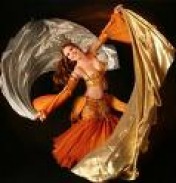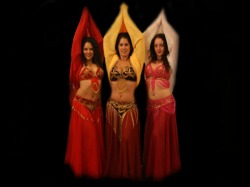Most people today are familiar with belly dancing as a form of entertainment. However, the dance can be traced back to over 6,000 years ago. The term belly dance comes from the French phrase “Dance du Ventre,” which means dance of the stomach. It also is referred to by the Arabic culture as “raks sharqui,” which means Dance of the East. Long ago, dance was associated with worship to fertility goddesses. According to professional belly dancer Caroline Kahled, “The dance was linked to fertility and often performed during childbirth.” Egyptian writers described it as we see it today with moving hips, circles, and shaking of the body.
During Ottoman rule, the dance began to evolve as women became respected for their artistic and moral abilities. Female intellectuals taught the dance to younger girls along with proper conduct, grace, and fine manners. The ghawazee, also known as invaders or outsiders, were also important, but not quite as well respected. Kahled states, “ They sang, told jokes, and interacted with the audience, but were linked to prostitution.” Their outfit was a bodice, belt, and head covering, which developed into the hip scarf normally worn today. In the 19th century, 400 ghawazee were captured and beheaded for socializing with the French and causing a disturbance. They were sent away to Cairo, and soon orientalists (artists, writers and, explorers), who were visiting the Middle East began to spread word of the dancers they saw. They brought back to the West images of nudity and eroticism that belly dancing portrayed, which greatly intrigued westerners.
Belly dancing often showed off the “roundness of the female body” and circular motions isolated different parts of the body. Moves, such as shoulder rolls, shimmy, hip circles, head flicks, and turns were used to show off femininity. Props and costumes, such as baskets, swords or canes, chiffon, and silk veils were also used. Arabic belly dance was typically used to display “emotion evoked by music.” According to WorldBellydance.com, gypsy tribes made the dance known as public entertainment. They danced in the streets and in theatres, traveling to Afghanistan, Persia, and eventually Europe. Gypsies began to settle in Turkey, and entertainment was requested of female dancers and musicians called chengis. The chengis helped to build the artistic style and characteristics belly dancers use today. Facial expression, veil dancing, and finger cymbal playing originated from the chengis.
Soon belly dancing was spread to the Midwest as a result of tourists. It became known as a unique form of art. It was first performed at the 1893 Chicago World’s Fair that displayed a dancer named Little Egypt. The hip and torso movements she used caused some controversy, but nonetheless the dance became popular and was used as a topic for many books, movies, and art. Today women the dance is used for both expression and exercise in the Midwest. According to ArtofBellyDance.com, “Belly Dance can strengthen the cardiovascular system, fend off osteoporosis, and improve stamina.” It can be used as a great method for weight loss and to achieve a better figure.
I chose this dance because although I have heard of it, I’ve never known where it came from or why women perform it. I really loved the costumes, and the way women could proudly show off their bodies with this dance. I’ve never seen a live performance, so watching videos of it was really interesting. It makes me happy seeing women perform it. It seems so freeing, and a great way to express not only the female body, but the emotions women feel. I can tell by watching that the dance is very sensual , and it creates a very appealing aura. I am really proud that the women continued to share belly dance even though they were punished.
During Ottoman rule, the dance began to evolve as women became respected for their artistic and moral abilities. Female intellectuals taught the dance to younger girls along with proper conduct, grace, and fine manners. The ghawazee, also known as invaders or outsiders, were also important, but not quite as well respected. Kahled states, “ They sang, told jokes, and interacted with the audience, but were linked to prostitution.” Their outfit was a bodice, belt, and head covering, which developed into the hip scarf normally worn today. In the 19th century, 400 ghawazee were captured and beheaded for socializing with the French and causing a disturbance. They were sent away to Cairo, and soon orientalists (artists, writers and, explorers), who were visiting the Middle East began to spread word of the dancers they saw. They brought back to the West images of nudity and eroticism that belly dancing portrayed, which greatly intrigued westerners.
Belly dancing often showed off the “roundness of the female body” and circular motions isolated different parts of the body. Moves, such as shoulder rolls, shimmy, hip circles, head flicks, and turns were used to show off femininity. Props and costumes, such as baskets, swords or canes, chiffon, and silk veils were also used. Arabic belly dance was typically used to display “emotion evoked by music.” According to WorldBellydance.com, gypsy tribes made the dance known as public entertainment. They danced in the streets and in theatres, traveling to Afghanistan, Persia, and eventually Europe. Gypsies began to settle in Turkey, and entertainment was requested of female dancers and musicians called chengis. The chengis helped to build the artistic style and characteristics belly dancers use today. Facial expression, veil dancing, and finger cymbal playing originated from the chengis.
Soon belly dancing was spread to the Midwest as a result of tourists. It became known as a unique form of art. It was first performed at the 1893 Chicago World’s Fair that displayed a dancer named Little Egypt. The hip and torso movements she used caused some controversy, but nonetheless the dance became popular and was used as a topic for many books, movies, and art. Today women the dance is used for both expression and exercise in the Midwest. According to ArtofBellyDance.com, “Belly Dance can strengthen the cardiovascular system, fend off osteoporosis, and improve stamina.” It can be used as a great method for weight loss and to achieve a better figure.
I chose this dance because although I have heard of it, I’ve never known where it came from or why women perform it. I really loved the costumes, and the way women could proudly show off their bodies with this dance. I’ve never seen a live performance, so watching videos of it was really interesting. It makes me happy seeing women perform it. It seems so freeing, and a great way to express not only the female body, but the emotions women feel. I can tell by watching that the dance is very sensual , and it creates a very appealing aura. I am really proud that the women continued to share belly dance even though they were punished.


